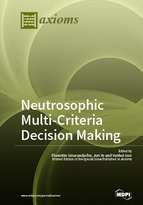Neutrosophic Multi-Criteria Decision Making
A special issue of Axioms (ISSN 2075-1680).
Deadline for manuscript submissions: closed (20 May 2018)
Special Issue Editors
Interests: neutrosophic probability; neutrosophic statistics; neutrosophic algebraic structures; plithogenic set; unmatter; superluminal physics; paradoxism; quantum paradoxes
Special Issues, Collections and Topics in MDPI journals
Interests: soft computing; fuzzy decision theory and method; robot intelligent control; pattern recognition and fault diagnosis; neutrosophic theory; rock mechanics; engineering modeling; optimization design
Special Issues, Collections and Topics in MDPI journals
Interests: artificial intelligence; computer vision; pattern recognition and image processing; medical information processing; fuzzy logic; neural networks; genetic algorithms
Special Issue Information
Dear Colleagues,
Neutrosophic logic and set are gaining significant attention in solving many real life problems that involve uncertainty, impreciseness, vagueness, incompleteness, inconsistent, and indeterminacy. A number of new netrosophic theories have been proposed and have been applied in Multi-Criteria Decision Making, computational intelligence, mutiple attribute decision making, image processing, medical diagnosis, fault diagnosis, optimization design, and so on.
Neutrosophic logic, set, probability, statistics, etc., are, respectively, generalizations of fuzzy and intuitionistic fuzzy logic and set, classical and imprecise probability, and classical statistics and so on.
As a founder of the field, I invite original research papers in this special issue that report on state-of-the-art and recent advancements Multi-Criteria Decision Making using neutrosophic environment to computing, artificial intelligence, big and small data mining, group decision making problems, pattern recognition, information processing, image processing, and many other practical achievements.
Prof. Dr. Florentin SmarandacheProf. Dr. Jun Ye
Dr. Yanhui Guo
Guest Editors
Manuscript Submission Information
Manuscripts should be submitted online at www.mdpi.com by registering and logging in to this website. Once you are registered, click here to go to the submission form. Manuscripts can be submitted until the deadline. All submissions that pass pre-check are peer-reviewed. Accepted papers will be published continuously in the journal (as soon as accepted) and will be listed together on the special issue website. Research articles, review articles as well as short communications are invited. For planned papers, a title and short abstract (about 100 words) can be sent to the Editorial Office for announcement on this website.
Submitted manuscripts should not have been published previously, nor be under consideration for publication elsewhere (except conference proceedings papers). All manuscripts are thoroughly refereed through a single-blind peer-review process. A guide for authors and other relevant information for submission of manuscripts is available on the Instructions for Authors page. Axioms is an international peer-reviewed open access monthly journal published by MDPI.
Please visit the Instructions for Authors page before submitting a manuscript. The Article Processing Charge (APC) for publication in this open access journal is 2400 CHF (Swiss Francs). Submitted papers should be well formatted and use good English. Authors may use MDPI's English editing service prior to publication or during author revisions.
Keywords
- Neutrosophic decision making theories and methods
- Neutrosophic operations used in MCDM
- Neutrosophic optimization
- Neutrosophic image processing using MCDM
- Neutrosophic fault diagnosis
- Neutrosophic medical diagnosis
- Neutrosophic data mining
- Neutrosophic clustering analysis
- Neutrosophic computational modelling
- NMCD Neutrosophic applications






